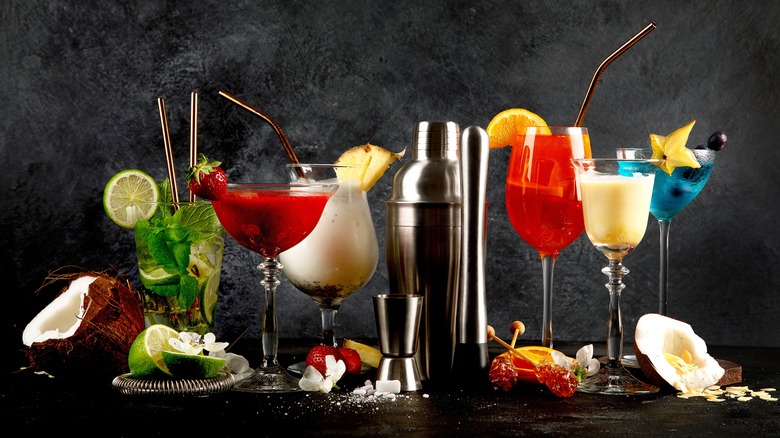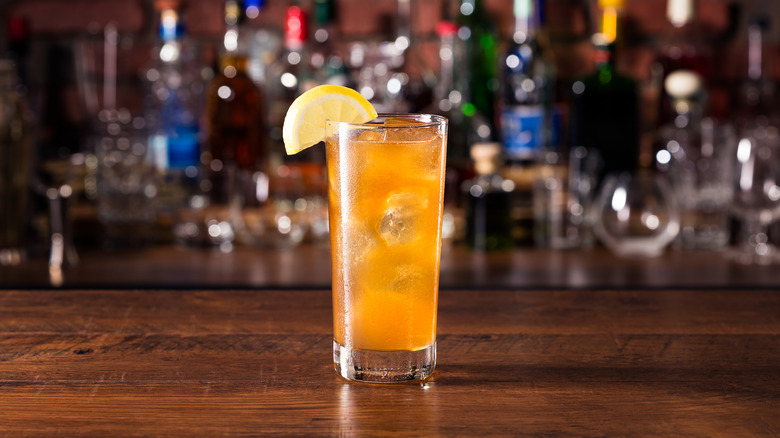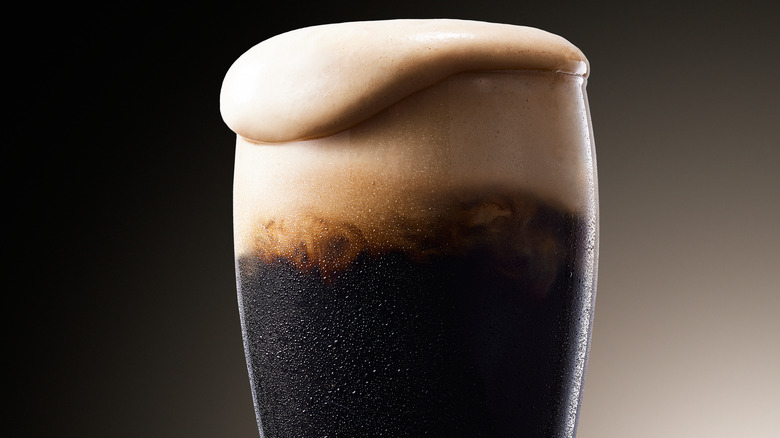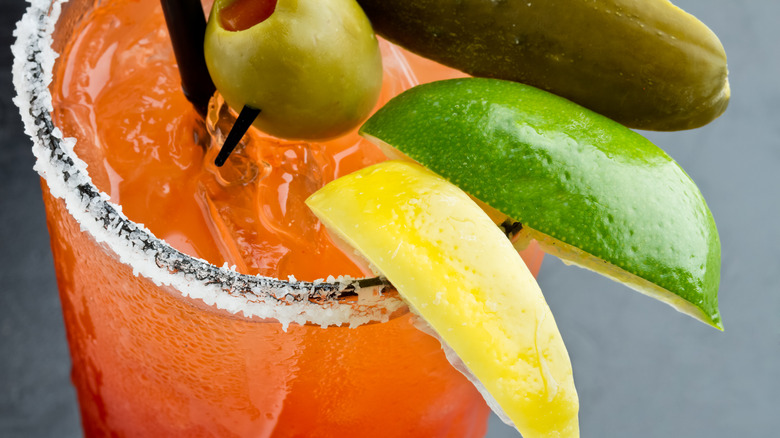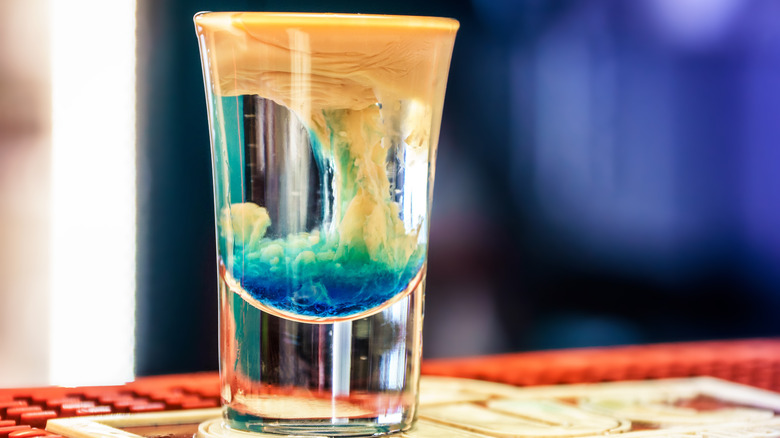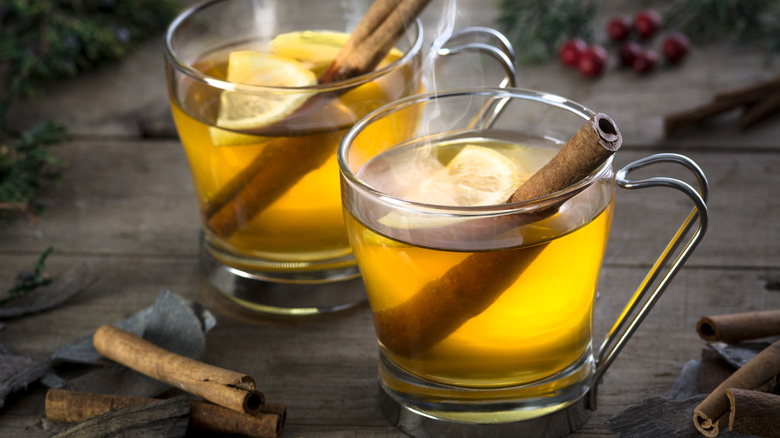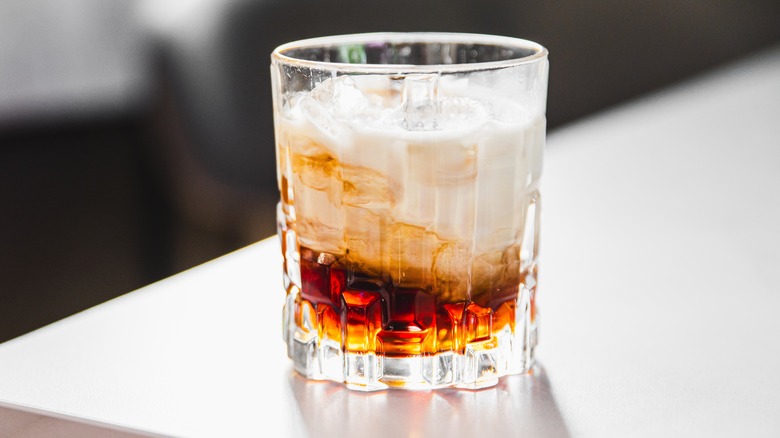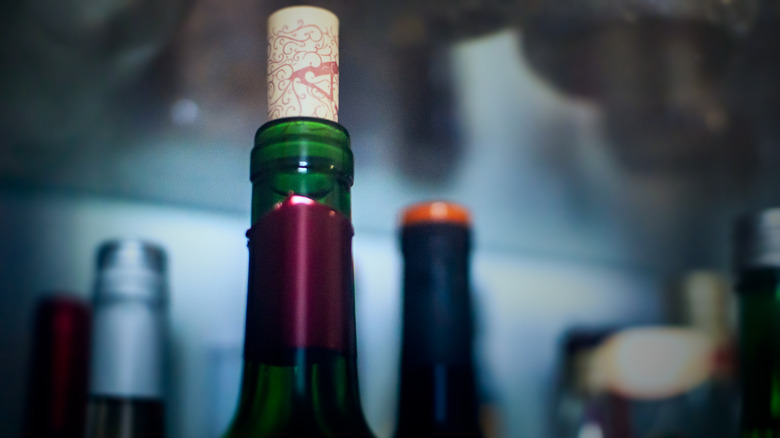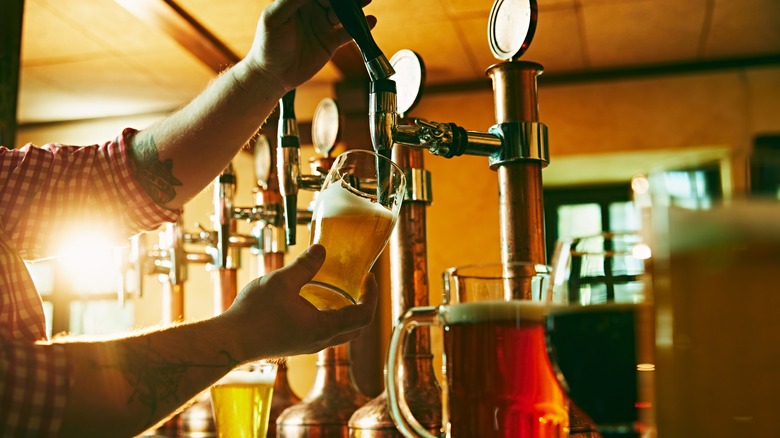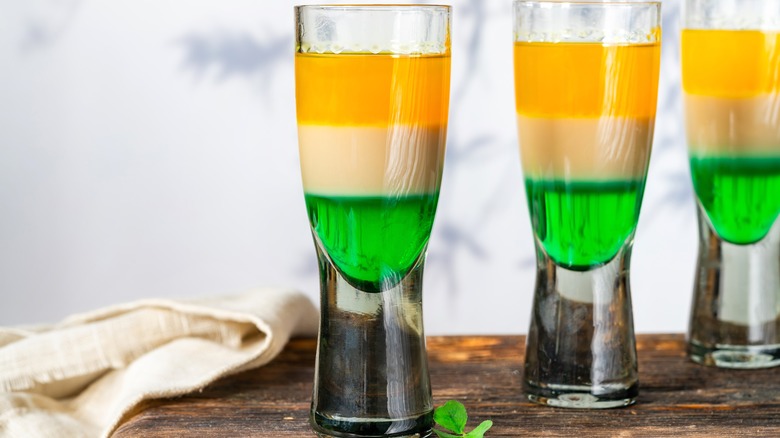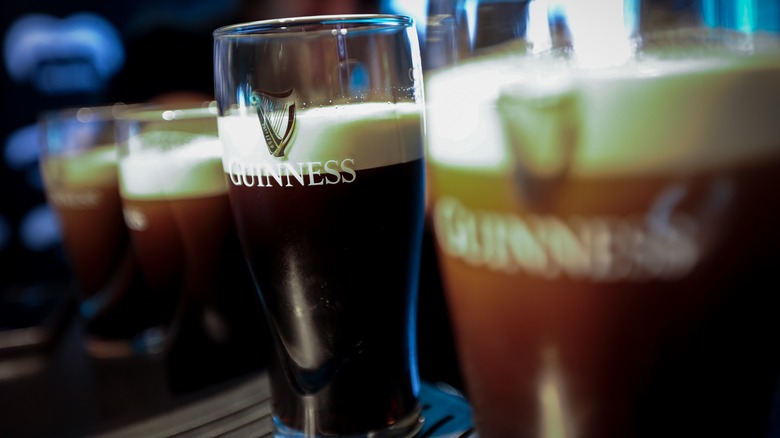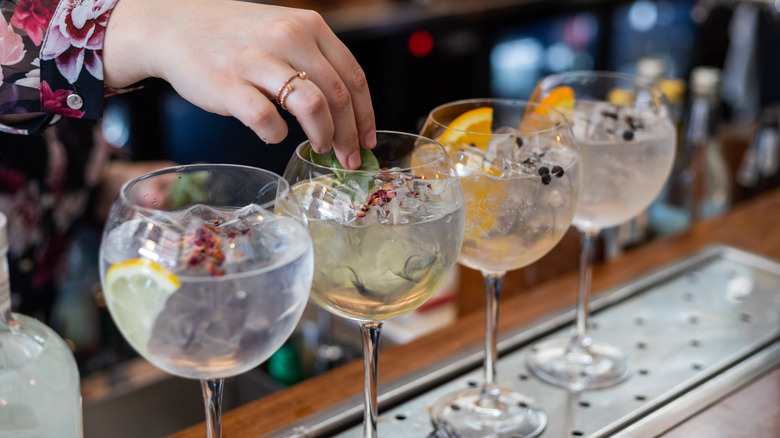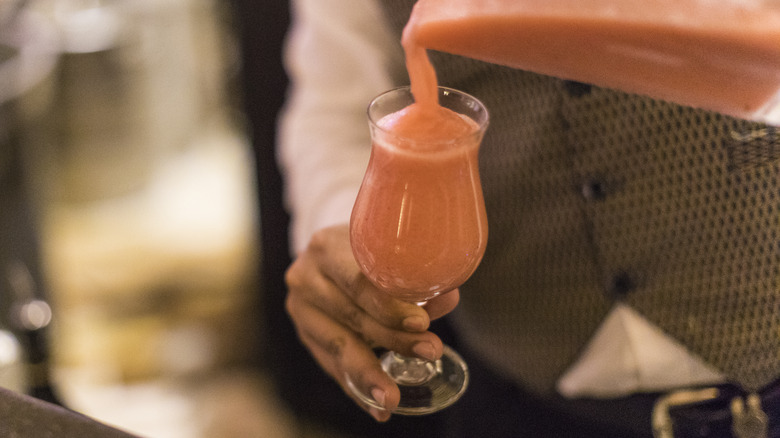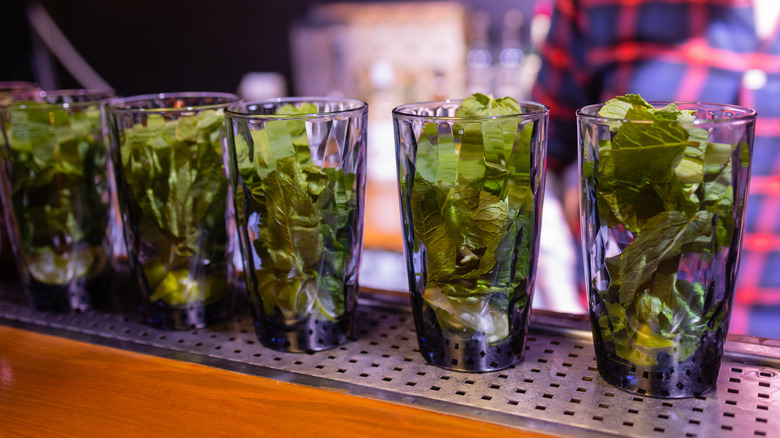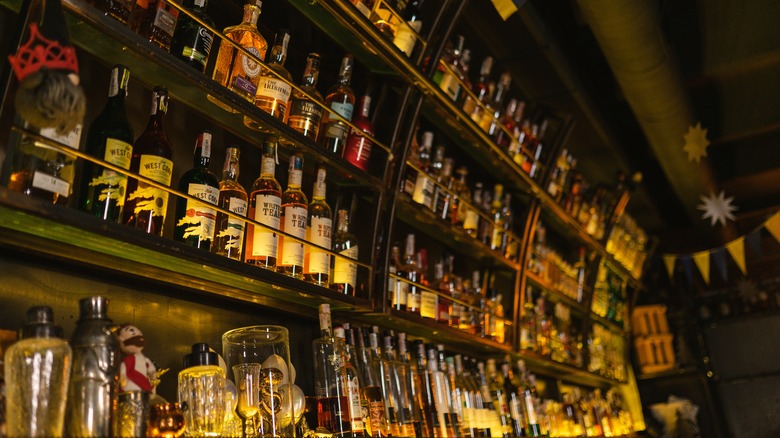14 Drinks You Should Think Twice About Ordering At A Bar, According To A Master Mixologist
Having spent over a decade behind all kinds of bars, from sports dives to wine-focused bistros, I've made and poured just about every drink under the sun. A bartender should happily and gracefully accommodate every customer's requests if possible, which is at the heart of hospitality. That said, there are some industry insights that a bartender like myself picks up as their career goes along that can help folks make the most of their drinking excursions. While you should never feel like you can't order the drink you want, certain beverages ordered in specific situations may result in a subpar experience for both the drinker and the drink maker, and the last thing a bartender wants is for their guest to feel shortchanged.
There are no hard and fast rules when it comes to ordering a drink when you're out at a bar, nor should there be. However, avoiding ordering drinks that may be more trouble than they're worth can make your time out less enjoyable. Think of this list more like suggestions or guidelines that can ensure you get the most bang for your buck every time you hit up a watering hole, regardless of whether it's a busy brewpub or a cocktail-slinging speakeasy, a bumping nightclub or a cozy tavern.
1. Long Island Iced Tea
It's something of a miracle that the Long Island iced tea is even drinkable, let alone tasty. Vodka, rum, tequila, and gin shouldn't go together, but somehow along with triple sec, lemon juice, and cola, the flavors meld to create a harmonious whole that's surprisingly easy to drink. Too easy, one might say — Long Island iced teas are notoriously boozy, and thus should always be considered with caution.
Before you order one of these potent potables, ask yourself: How bad do you want to feel tomorrow? The combination of different spirits, along with the sugar from triple sec and cola, is basically a perfect storm of hangover fodder. Ask yourself this question, too: How closely do you want to be monitored? Ordering a Long Island is a sign to many bartenders that you're looking to get quite drunk, quite quickly, which means the staff will probably be keeping a close eye on you to make sure you don't get overserved. Since the drink is so strong, you may be limited to ordering one or two, and depending on the establishment, might even get cut off from ordering more drinks after that.
2. Irish Car Bomb
Each component of this drink — Irish stout (typically Guinness), Irish whiskey (usually Jameson), and Irish cream (commonly Bailey's) — is delicious and should be enjoyed and celebrated. The problems that arise from this drink have nothing to do with its ingredients. Let's start with the name. Coined in Connecticut by a bar owner in the late 1970s, it referred to the Troubles, an era of violence that plagued Northern Ireland for decades. Thousands of people were killed and wounded in the conflict which included many bombings, making the name distasteful at best, and to people who lived through the era, extremely offensive. It should never be ordered by its original name no matter what, but especially if you're at an Irish pub, in Ireland or elsewhere.
These days, some have rebranded this drink as the Irish shot or Irish slammer, making it less problematic to order. Even so, there are some other issues that may raise some eyebrows if this drink is asked for. The Irish cream and whiskey are poured into the same shot glass, which is then dropped into the pint of Guinness. The dairy component of the Irish cream curdles if left in the glass with the other ingredients, which encourages the drinker to chug the whole thing. This can lead to folks quickly getting very drunk. Dropping the shot in the beer can also cause chips and cracks in either glass, and tends to make a big mess.
3. Bloody Mary at the wrong time or place
One of the great pleasures of brunch is the bloody mary cocktail, and what's not to love? It's savory, spicy, boozy, and often ornately garnished with snacks — sometimes even sandwiches like mini BLTs. However, if you're out at night or in a bar that doesn't serve brunch, or food at all, steer clear of this drink. They may be able to make one for you, but if a bar isn't set up to make these on a frequent basis, you're not likely to get a good one.
The bloody mary recipe calls for very specific ingredients, most of which aren't used in any other drinks. That means a bar that doesn't have much call for this cocktail might not have everything they need to make one — or if they do, the ingredients aren't likely to be fresh or high-quality. That can of tomato juice may have been sitting in storage for literal years, and who knows how long the horseradish has been stowed away somewhere. Maybe there's some celery lying around for a garnish, but it's likely wan and limp, probably leftover from the last time someone ordered a bloody mary, weeks before. It's a great drink, but only in the right time and place.
4. Cement Mixer or other gross-out shots
Many of us have likely had the indignity of drinking a cement mixer, or one of its similarly gross brethren, on our 21st birthday. It's something of a rite of passage for young drinkers who may not know any better, or who have prankish friends that enjoy hazing. Other than that very specific situation, there's no reason to order one of these loathsome shots that are really only designed for shock value and to make people sick. No bartender wants to deal with a vomiting patron.
There are tons of examples of this type of shot, many of which have names too vulgar to mention here. Anything that involves curdling, like the cement mixer which consists of Irish cream and lime juice, falls under this category, as well as drinks that include odd ingredients like mayonnaise or hot sauce. Flaming shots are another category to avoid ordering, unless you're at a bar that features them. The last thing you want is to force a bartender to play with fire and alcohol when they're not experienced with the practice.
5. Hot drinks out of season
Hot toddies, hot buttered rums, and other warming drinks are lovely when the weather is chilly. If it's the middle of summer, though, and the temperatures are sweltering, these drinks are probably not on any bartender's radar, and that means they're not properly set up to make them. They might be able to throw one together for you, but it'll probably take a long time and may be missing vital ingredients. Best to order seasonal drinks when they're in season.
Coffee drinks are more commonly ordered year-round, but take a look at the bar setup — if you only see an old, stained, chipped coffee pot with sludgy-looking coffee in it that may or may not have been made today, you might want to get your caffeine fix another way. If there's a gleaming espresso machine, you're probably good to go. If you're not sure, it's always a good idea to ask the bartender if they can make coffee drinks. Just be prepared with a plan B if they say they're not.
6. White Russians and other dairy-based drinks
White Russians, grasshoppers, Brandy Alexanders, and other drinks that have a dairy component are unquestionably delicious. They make great dessert drinks, nightcaps, or sweet and creamy pick-me-ups whenever you need to indulge in a decadent treat. Keep in mind, though, that it's risky to order these at a bar unless they're specifically featured on the drink list or menu.
If a bar doesn't make these types of drinks often, they probably don't restock their dairy very frequently, which means the milk or cream they have in the fridge is probably not fresh, and may not even be safe to drink. You're probably in good hands if you're ordering these drinks at a restaurant bar, as the kitchen likely has a constant supply of fresh dairy. If you're at a dive bar, a sports bar, or a brewpub, you'll probably want to ask the bartender to double-check the freshness before you set your heart on one of these creamy cocktails.
7. Wine at a non-wine bar
Once a bottle of wine is opened, the clock starts ticking on its quality. Exposure to oxygen slowly degrades a wine's freshness, aromas, and flavors, and depending on the wine, within hours or days, it can become flavorless or, in some cases, virtually undrinkable. if you're at a wine bar or any kind of bar that has an extensive wine list, you know you're in good hands. At a different type of bar, however, one that features beer or cocktails perhaps, ordering a wine can be risky.
If you can see the wines a bar has available, take a look at the bottles. Do they have a layer of dust on them? Are they stopped with corks, or do they have special wine closures? If the bottles look like they've been sitting there untouched for a while and not properly sealed, you may want to order something else, as those bottles may have been sitting open for ages. You can always ask the bartender to open a fresh bottle for you if it tastes off, but at a place where wine is that much of an afterthought, you're probably better off with a different drink anyway.
8. Draft beer at a not-so-clean joint
Beer might seem like a safe choice no matter what type of bar you're visiting. For bottles and cans, that's probably true. For draft beer, however, there's another factor that you should consider before you settle on it as your drink of choice. As beer makes its way from the keg to the tap, it flows through pressurized tubes known as beer lines or keg lines. Over time, that beer leaves residue behind. A well-functioning bar will clean these beer lines frequently, but there are plenty that don't, and if left uncleaned, this residue can harbor bacteria, mold, you name it. This, of course, adversely affects the taste and quality of the beer, and it can even make you sick.
If a bar's taps don't look particularly shiny and clean, it may be best to assume their lines aren't in tip-top shape, either. If you've ordered a draft beer and it tastes unpleasantly funky or off, it could be from dirty lines. There's no way of knowing unless you ask, but the bartender may not know what the beer line cleaning situation is. Consider ordering a bottle or can of beer instead, if you run into this situation.
9. Layered shots
Layered shots look incredibly cool and are fun to drink. They're also fun to make. The relative density of different liquors allows some to float on top of others, so layered shots involve knowledge and skill to create, two things that bartenders are often eager to display. These drinks are, however, labor-intensive and time-consuming to make. A layered shot that may take several minutes to put in a glass only takes one second to consume, at which point the patron might ask for another one, and other people around who see the cool-looking shot suddenly decide they want one too. This time really adds up, and if the bar is busy, it can totally derail service for everyone.
Ordering layered drinks is a read-the-room situation — if the bartender is busy and clearly stressed, that's probably not the best time to order a layered shot or any other complicated, time-consuming cocktail. However, if the bar isn't too crowded, you're more likely to get a bartender who's happy to show off their layering skills.
10. Guinness at the wrong time or place
A properly poured Guinness is an unparalleled thing of beauty. The technique to create such a glorious pint is no joke, and requires specific glassware, the right keg system, and several detailed steps that must be followed to the letter. This process takes time and skill, and not every bar has the setup or the trained staff to make it happen. Even a poorly poured Guinness still tastes good, but it's not the real deal.
There are plenty of bars that pride themselves in their Guinness pouring mastery, and you should feel absolutely empowered to order this beautiful beer in such fine establishments. Be prepared to wait for a great Guinness, as the correct method requires the beer to settle between two separate pours. But if you're in a bar that doesn't seem to be on top of its Guinness game, especially one that's very busy, you may want to opt for a less complicated beer instead.
11. Drinks with specialized garnishes
No matter what kind of bar you're at, you should have no issue getting a lime or lemon wedge for your drink. Olives and cherries are also common. However, if you have your heart set on a less common special garnish, you might be disappointed. Not every bar has garlic-stuffed olives, or Bobby Flay's favorite Amarena cherries, or edible flowers. Even a bar that specializes in complex cocktails might not have a particular garnish you have in mind, as they often only keep around what they need for the custom drinks on their menu.
If you can't enjoy your martini without a blue cheese-stuffed olive garnish, you might want to have a backup drink ready in case the bar isn't able to accommodate your request. Some no-frills bars may not even have sugar or salt for your rim, which can affect your enjoyment of drinks like lemon drops or margaritas. These may seem like simple things to procure, but if a bar doesn't have them handy, it's because they don't use them enough to keep them around.
12. Frozen margaritas or other blended drinks
Frozen drinks are delightfully refreshing on a hot day, like a beach vacation in a glass. Something to keep in mind, though, is that they don't just magically appear in their cool icy form. They have to be made using a very noisy, very disruptive blender. Some places specialize in them, and if it's a loud bar you probably won't notice the racket. Try to read the room, though, before you order one — is there a pianist or a folk guitarist playing soft music? Are people speaking quietly? If so, it's not the place for the loud, crunchy whirr of a blender.
If you see a blender or two behind the bar, don't hesitate to order a frozen margarita or piña colada or any other blended drink. Blenders might not always be visible, so it never hurts to ask if they can make one for you. Just be prepared to order something else if the bar is not set up for these types of cocktails.
13. Mojitos or other muddled cocktails
If you are at a bar that has a mojito on the menu, ordering one should be no problem. These drinks, because they involve muddling fresh mint, are time-consuming and labor-intensive to make. However, if a bar features them, that means they're set up to make them efficiently, by bar staff who are properly trained and with ingredients that are fresh and prepped. A mojito is the kind of drink that greatly suffers if any one ingredient or technique is off, so if you see limp old mint leaves or a bartender who can't find a muddler, you're probably not in the best place to enjoy this particular cocktail.
At a bar that's crowded and busy, and that's not set up for high-volume mojito preparation, you might have to wait a long time to get this drink, which is another reason to reconsider ordering it in certain situations. It's always okay to ask the bartender if a mojito is a good drink to order there or not — places that are properly set up won't hesitate to say yes, but if you sense hesitation, you might want to go down a different road.
14. Top-shelf liquor in a mixed drink
If you're springing big bucks for a single malt Scotch or a rare bourbon, think twice before adding too much to it. Water, ice, even a splash of soda will all enhance the spirit without changing it much, and after all, you want to taste a top-shelf liquor as intensely as you can. Maybe you're not in the mood to sip something slowly, though, or you like a drink with more mixer. In that case, you might want to drop your eyeline down a few shelves.
When ordering a special, high-end spirit, the last thing you should do is mix it with cola, juice, or anything else that's going to compromise its flavor. Of course, anyone should be free to drink whatever they'd like, but if you're going to completely change the flavor of a spirit by adding a strong mixer, you may as well go for the cheaper stuff and save your money.
